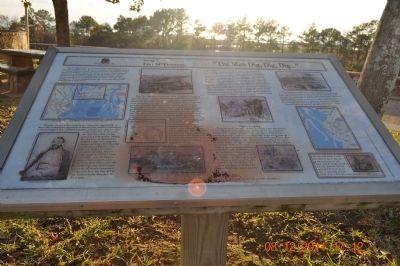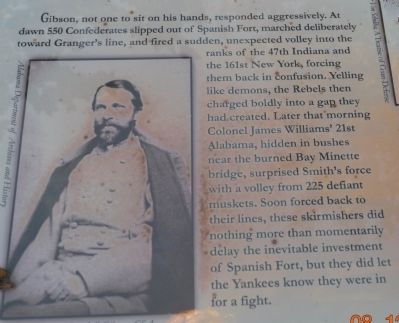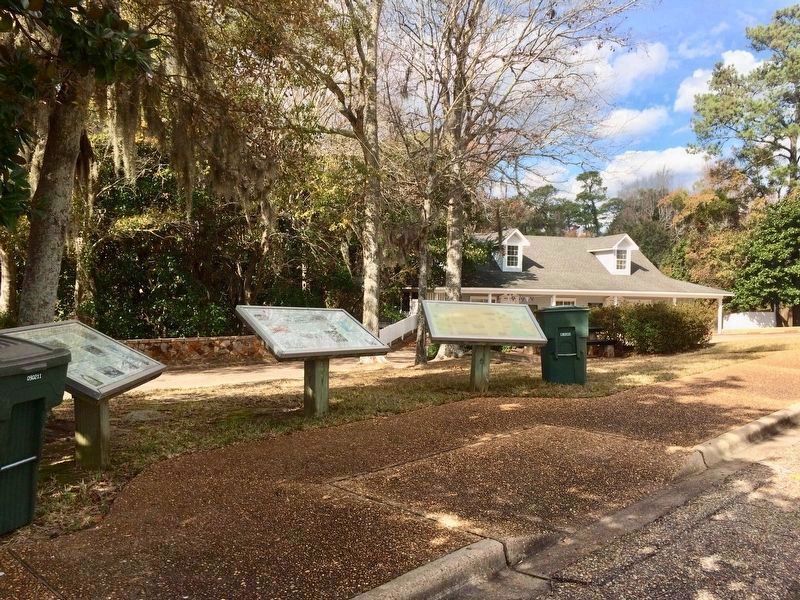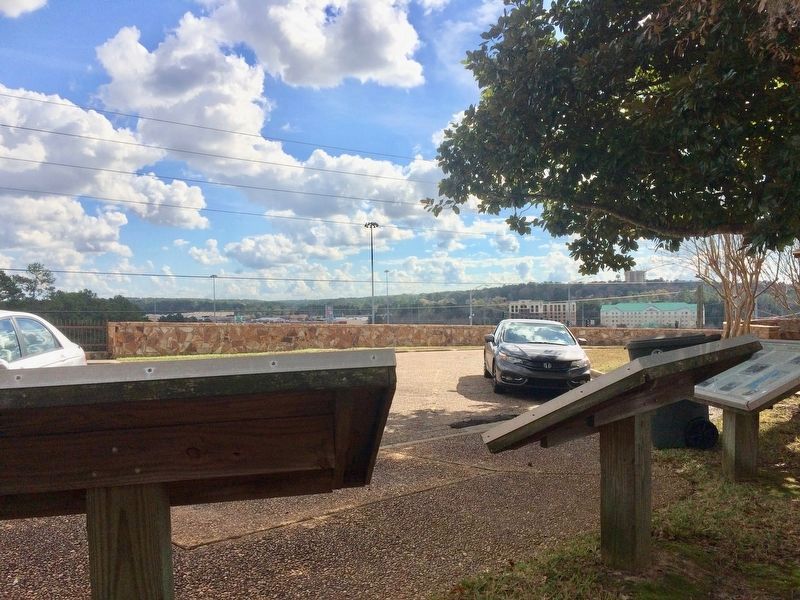Spanish Fort in Baldwin County, Alabama — The American South (East South Central)
Stop 7 Fort McDermott:
"The Men Dig,Dig,Dig"
— Civil War Trail —
Gibson, not one to sit on his hands, responded aggressively. At dawn 550 Confederates slipped out of Spanish Fort, marched deliberately toward Granger's line, and fired a sudden, unexpected volley into the ranks of the 47th Indiana and 161st New York, forcing them back in confusion. Yelling like demons, the Rebels then charged boldly into a gap they had created. Later that morning Colonel James William's 21st Alabama, hidden in bushes near the burned Bay Minette Bridge, surprised Smith's forces with a volley from 225 defiant muskets. Soon forced back to their lines, these skirmishers did nothing more than momentarily delay the inevitable investment of Spanish Fort, but they did let the Yankees know they were in for a fight.
From the edge of the woods east of the Confederate stronghold lay a sloping plain- filled with fallen trees and naked stumps for a thousand yards, tangled abates fifteen feet wide, a ditch eight feet wide by five feet deep, a line of rifle pits, breastworks of timber and earth ten to fifteen feet high, six redoubts bristling with cannon muzzles, a hundred foot bluff, a bastioned water battery, and the Blakeley River. Torpedoes, which sank three ships during the siege, guarded the fort's water approaches. Hundreds of subterra shells (land mines) similarly protected its landward approaches. Gibson's batteries mounted 47 field guns, Coehorn mortars, and heavier guns, including Columbiads, Parrots, and Brooke Rifles. The enterprising garrison of 1,810 men- which included at least one company of black artillerymen- while digging day and night to strengthen the works, placed steel plates over the embrasures to protect the artillerymen and made wooden mortars from gum stumps to add to the fort's fire power. The fort was weakest on its extreme left. It had not been fortified there, because it bordered a nearly impassible swamp.
Canby's division fought through the tangle of trees to tighten the cordon around the fort from north, south, and east, Gibson's line, bright with "fluttering battle flags," opened its guns on the enemy. His skirmishers, using trees and hills for cover, engaged the Yankees in an active
defense along their entire front but were pushed steadily back. A little after noon, Canby's field guns finally began to answer the Rebel batteries. In front of the Confederate's strongest bastion on the forward line, Fort McDermott, Granger's and Bertram's regiments met stiff resistance from artillery fire and musketry. Through the fallen trees made progress difficult, the Federals pushed the southerners back to the fort and set up the 7th Massachusetts Light Battery within 750 yards of McDermott's 25foot ramparts. By nightfall, Canby's front lay with a thousand yards of Gibson' s main works along the line. General John McArthur, asked if he thought the Federals should assault Spanish Fort, replied, "My division will go in there if ordered, but if the Rebels stay by their guns, it will cost the lives of half my men." Saying, "It won't pay," Canby set the men to work entrenching.
Using the spade, the pick, and the ax, Canby would take Spanish Fort by digging zigzag approaches toward and trenches parallel to Gibson's breastworks. His skirmishers, sometimes firing almost muzzle to muzzle, sought to keep the Rebels' heads down, while the men dug night and day. Gibson sent out at least 12 sorties in an effort to delay the inevitable. In the most successful, on March 31, Captain Clement Watson, Gibson's inspector-general, let 16 officers and men out of Fort McDermott under
cover of smoke at sunset Watson captured Captain R.B. Stearns of the 7th Vermont Infantry and twenty of his men and escorted them back to McDermott. This exploit made the Yankees more cautious, and Gibson's vigorous defense led some to believe the Rebels had up to 15,000 men within the fort.
"Our rifle pits are some of them [as of April 6] within 150 yards or so of the Rebel forts a& batteries -- the men dig, dig, dig, day & night, with accoutrements on, & their trusty rifles by their sides in the trenches. The Rebels dig too, and we have to be cautious not to expose ourselves too far, or whiz goes a bullet, much too close to one's head to be pleasant for a timid man. Sometime they rain around us like hail, and I wonder that the casualties are so few." Captain Thomas N Stevens, 28th Wisconsin Infantry.
Both sides made mortars of three-foot sections of logs, of eight gum or oak, bored out at one end. These could be strengthened with iron hoops, lined with sheet iron, and used in the trenches by two men. A small charge of power would throw a shell with a short fuse into the enemy's works.
Topics. This historical marker is listed in this topic list: War, US Civil. A significant day of the year for for this entry is March 26.
Location. 30° 39.525′ N, 87° 54.706′ W. Marker is in Spanish Fort, Alabama, in Baldwin County. Marker is on Larry
Dee Cawyer Drive. Touch for map. Marker is at or near this postal address: 29750 Larry Dee Cawyer Drive, Spanish Fort AL 36527, United States of America. Touch for directions.
Other nearby markers. At least 8 other markers are within walking distance of this marker. “Damn The Torpedoes!” (here, next to this marker); Stop 8 The Eighth Iowa Line: (here, next to this marker); Revolutionary War Battlefield and Burial Ground at Spanish Fort (1780-1781) (within shouting distance of this marker); Fuller Memorial Park (approx. 0.3 miles away); Union Siege Battery No. 1 (approx. half a mile away); The Eastern Shore Trail (approx. half a mile away); Albert Carey Danner (approx. 0.7 miles away); Confederate Drive (approx. 0.7 miles away). Touch for a list and map of all markers in Spanish Fort.
Also see . . .
1. St. John Richardson Liddell. St. John Richardson Liddell (September 6, 1815 – February 14, 1870) was a prominent Louisiana planter who served as a general in the Confederate States Army during the American Civil War. He was an outspoken proponent of Southern emancipation of slaves. Liddell was murdered by a former Confederate Officer near his home in 1870. (Submitted on December 17, 2011, by Sandra Hughes Tidwell of Killen, Alabama, USA.)
2. Francis Marion Cockrell. Francis Marion Cockrell (October 1, 1834 – December 13, 1915) was a Confederate military commander and American politician from the state of Missouri. He served as a United States Senator from Missouri for five terms. He was a prominent member of the famed South–Cockrell–Hargis family of Southern politicians. (Submitted on December 17, 2011, by Sandra Hughes Tidwell of Killen, Alabama, USA.)
3. Randall Lee Gibson. Randall Lee Gibson (September 10, 1832 – December 15, 1892) was a U.S. Senator and a member of the House of Representatives from Louisiana. He was also a brigadier general in the Confederate States Army, a regent of the Smithsonian Institution, and a president of the board of administrators of Tulane University. (Submitted on December 17, 2011, by Sandra Hughes Tidwell of Killen, Alabama, USA.)
4. John McArthur. John McArthur (November 17, 1826 – May 15, 1906) was a Union general during the American Civil War. McArthur became one of the ablest Federal commanders in the Western Theater.[ (Submitted on December 17, 2011, by Sandra Hughes Tidwell of Killen, Alabama, USA.)
5. Capt. Thomas N. Stevens Company C. Captain Stevens also served as president of the 28th Regiment reunion association for several years. He died January 1, 1908, at his home in Stanton and was buried at the family lot in Forest Hill Cemetery, Greenville. (Submitted on December 17, 2011, by Sandra Hughes Tidwell of Killen, Alabama, USA.)
Credits. This page was last revised on January 14, 2017. It was originally submitted on December 17, 2011, by Sandra Hughes Tidwell of Killen, Alabama, USA. This page has been viewed 2,824 times since then and 73 times this year. Last updated on September 25, 2015, by Eric Polk of Lakewood, California. Photos: 1, 2. submitted on December 17, 2011, by Sandra Hughes Tidwell of Killen, Alabama, USA. 3, 4. submitted on January 14, 2017, by Mark Hilton of Montgomery, Alabama. • Bernard Fisher was the editor who published this page.



